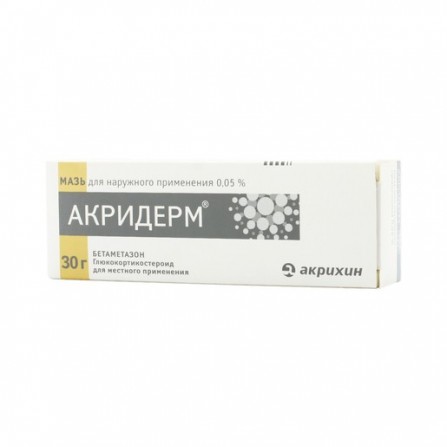More info
Active ingredients
Salicylic acid
Release form
Ointment
Composition
Active ingredient: Betamethasone + Salicylic Acid (Betamethasonum + Acidum salicylicum) Active ingredient concentration (mg): Betamethasone dipropionate 64 mg, salicylic acid 3 g
Pharmacological effect
GCS, has anti-inflammatory, antipruritic and vasoconstrictor action.
Pharmacokinetics
Data on the pharmacokinetics of the drug is not provided.
Indications
Simple and allergic dermatitis (especially complicated by secondary infection), diffuse neurodermatitis (including atopic dermatitis), limited neurodermatitis (including simple chronic lichen), eczema, dermatomycosis (dermatophytosis, candidiasis, varicolor versicolor), especially localization in the groin and large folds of the skin.
Contraindications
Hypersensitivity to any of the components of the drug, skin tuberculosis, skin manifestations of syphilis, chicken pox, herpes simplex, skin post-vaccination reactions, open wounds, children's age (up to 2 years).
Precautionary measures
Do not exceed recommended doses.
Use during pregnancy and lactation
Due to the fact that the safety of using local corticosteroids in pregnant women has not been established, the use of drugs of this class during pregnancy is justified only if the benefit to the mother clearly exceeds the possible harm to the fetus. Preparations of this group cannot be used in large doses for pregnant women for a long time. Since it has not yet been established whether glucocorticosteroids, when topically applied and systemic absorption can penetrate into breast milk, a decision should be made to discontinue breastfeeding or discontinue the drug, given how necessary is its use for the mother.
Dosage and administration
Outwardly. The ointment is applied to the affected skin, gently rubbing a small amount 2 times a day. The duration of treatment is determined individually and depends on the nosological form and severity of the disease. In case of ringworm, the average duration of treatment is 2-4 weeks. If clinical improvement does not occur in the near future, it is necessary to clarify the diagnosis or change the treatment regimen.
Side effects
Itching, burning, irritation, dry skin, folliculitis, hypertrichosis, steroid acne, hypopigmentation, allergic reactions. When using occlusive dressings maceration, infection, skin atrophy, stretch marks, prickly heat. With prolonged treatment or application to a large surface - the development of systemic side effects: weight gain, osteoporosis, high blood pressure, edema, ulceration of the gastrointestinal mucosa, exacerbation of hidden lesions, infections, hyperglycemia, agitation, insomnia, dysmenorrhea.
Overdose
Symptoms: excessive or prolonged use of local corticosteroids can cause depression of the function of the pituitary-adrenal system, which can cause the development of secondary insufficiency of the adrenal cortex and the appearance of symptoms of hypercorticism, including Cushing syndrome. Treatment: appropriate symptomatic treatment is indicated. The acute symptoms of hypercorticism are usually reversible. If necessary, correction of electrolyte imbalance is shown. In the case of chronic toxic effects, the gradual abolition of the GCS is recommended.
Interaction with other drugs
No clinically significant interactions with other drugs.
special instructions
In the absence of the effect of treatment within two weeks, it is recommended to contact your doctor for possible clarification of the diagnosis. If the use of the drug marked irritation or hypersensitivity reaction, treatment should be stopped and contact your doctor. When secondary fungal or bacterial infection is necessary to apply the appropriate drugs. If there is no, at the same time, a quick positive effect, the use of Acriderma should be discontinued until all signs of infection are eliminated. Long-term use of the drug on the skin of the face is not recommended. Do not use Akriderm in the eye area, as in this case, the development of cataracts, glaucoma, fungal infection and exacerbation of herpes infection is possible. Use in pediatrics Children may be more susceptible to the use of local GCS, causing depression of the hypothalamic-pituitary-adrenal system (HGN) than older patients, due to increased absorption drug associated with a larger ratio of their surface area and body weight.In children who took local GCS, the following side effects were noted: suppression of the HGN system function, Cushing syndrome, linear growth retardation, lag in weight gain, increased intracranial pressure. Symptoms of inhibition of adrenal cortex function in children include a decrease in plasma cortyazole and a lack of response to stimulation of ACTH. Increased intracranial pressure is manifested by bulging of the fontanel, headache, bilateral swelling of the optic nerve head.





